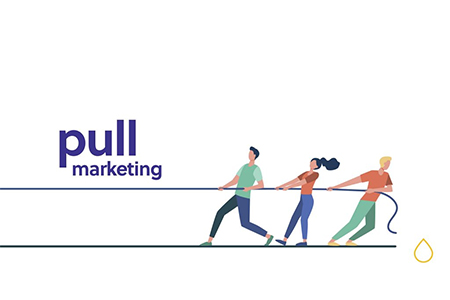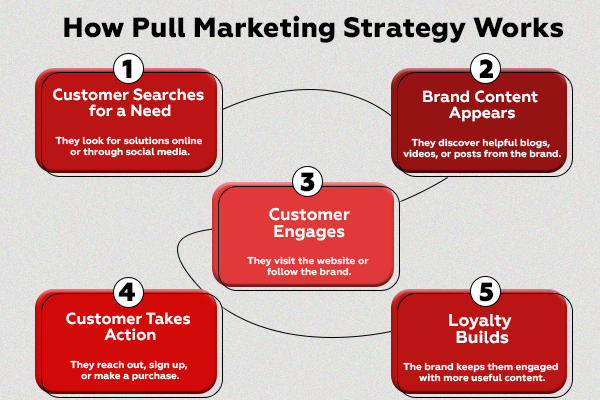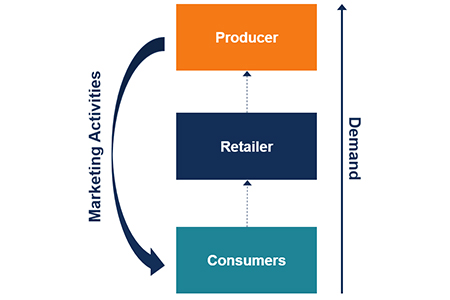
Ever walked into a store just because the smell of fresh coffee caught your attention? Or clicked on a blog because the headline spoke directly to a problem you were trying to solve?
That is a pull strategy in action.
It is not loud. It does not interrupt. It does not beg for attention. Instead, it attracts — by being helpful, engaging, and visible where it matters most.
If you are a business or brand owner, understanding how to bring customers to you instead of chasing them is one of the most valuable strategies you can learn. This blog explores the power of the pull marketing strategy, how it works, why it matters, and how to apply it using real-world examples.
What is the Pull Marketing Strategy?

Pull marketing strategy is all about attracting customers by offering value. It helps people find your business when they are actively looking for a solution, rather than you placing an ad in front of them when they are not.
In simple terms, if you have ever asked, "What is pull strategy?" — it is the approach where customers seek out your brand because of the content, credibility, or word-of-mouth they encounter.
A solid pull strategy is appropriate to build long-term brand trust and engage audiences who are already interested in what you offer.
How Pull Marketing Strategy Works?

A pull strategy works by making your brand discoverable and valuable across the places your audience visits. Whether it is Google search, social media, or email inboxes, this approach builds curiosity and trust.
Here is the process behind it:
- Know your audience – What are they searching for? What problems do they want to solve?
- Create helpful content – Whether it is blog posts, guides, or videos, give them answers they value.
- Be visible – Use SEO, social platforms, and email newsletters to place your content in front of them.
- Build relationships – Reply to questions, encourage engagement, and become a brand they remember.
- Earn their interest – With consistent value, people naturally return, refer, and convert.
Advantages of Pull Marketing Strategy

A strong pull marketing strategy brings several advantages for businesses and brands that are playing the long game.
Improved Organic Reach and Visibility
When you create content around what your audience is already searching for, you improve your chances of showing up in search results. That means more people discover you without paying for every click.
Unlike paid ads, which disappear the moment you stop funding them, content built on a pull strategy keeps working for you over time.
Long-Term Brand Growth
The more value you offer upfront, the more trust you earn. People remember the brands that helped them, not just the ones that sold to them.
That is why pull marketing plays such a big role in brand growth. It leads to loyal followers, not just one-time buyers.
Better Customer Insights Through Search Behavior
By observing how people find and interact with your content, you get real insights into what they care about.
That data is gold. It helps you adjust your approach and provide even more helpful content in the future — something every smart brand should be doing.
Higher Conversion Rates
Visitors who come to you through search, referrals, or shared content are already interested. They are looking for something. And that often means they are more likely to convert.
This is one of the reasons why pull marketing typically produces better quality leads compared to cold outreach.
Enhanced Content Strategy
The heart of a good pull marketing strategy is valuable content. That content helps at every stage — from educating new visitors to answering questions from paying customers.
It becomes a resource your audience depends on. That deepens your brand’s relationship with them.
Disadvantages of Pull Marketing Strategy

While powerful, a pull strategy is not without its challenges. Here are a few things to consider.
Dependence on Search Engine Algorithms
Much of the success of a pull strategy relies on being discoverable online. But search engines often update how they rank content. That means your visibility can change overnight if your content is not kept up to date.
This is why spreading your presence across email, social media, and referrals is a smart move.
High Initial Investment in Content Creation
Creating quality blogs, videos, or guides is not cheap or quick. It requires time, effort, and skill.
That upfront cost may feel steep, but it builds assets that pay off over time. You are investing in something lasting, not just a short-term win.
Requires Constant Monitoring and Optimization
Content is not one-and-done. It needs updating, reworking, and ongoing promotion.
A great pull strategy is an ongoing effort. But with regular attention, it delivers steady results.
Difficulty in Measuring Short-Term ROI
Pull strategies often take months before showing real impact. That makes it harder to measure return in the early stages.
But if your focus is long-term success and brand equity, then this strategy aligns perfectly.
Types of Pull Marketing Strategy

There are many ways to execute a pull marketing strategy. Here are some of the most effective types that brands use.
Influencer Marketing
When influencers share your product with their audience, it builds immediate trust. People see the recommendation as honest and personal.
This is a modern pull strategy example that works because it feels natural — not forced.
Email Marketing (Lead Nurturing)
Email is not just for selling. When used to educate or inspire, it helps keep your brand in mind while building relationships over time.
This type of pull marketing creates a strong connection through consistent value.
Referral Programs and Word-of-Mouth Marketing
Nothing beats a friend’s recommendation. Referral programs turn happy customers into promoters by rewarding them for sharing.
This approach uses real voices and trust to bring in new business — making it a classic pull strategy example.
Content Marketing and Blogging
Blogging is at the core of most pull marketing strategies. When you write about the topics your audience is already searching for, you pull them toward your brand.
Well-written blogs do not just inform. They build authority, answer questions, and create long-term trust.
Examples of Pull Marketing Strategy

Real-world pull marketing examples show how this strategy works across different industries and platforms.
HubSpot
HubSpot built its brand by offering free guides, templates, and blog content. Their pull strategy drives millions of visitors every month — no cold calls needed.
Dropbox
Dropbox grew rapidly by offering extra storage space to users who referred others. That is a simple and effective pull strategy example.
Glossier
Glossier built its brand using real customer reviews and social media buzz. The community did the marketing — and that made the brand feel authentic and personal.
Airbnb
Airbnb used travel content, host stories, and local tips to draw people in. They were not just selling stays — they were selling experiences.
Neil Patel
Neil Patel’s blog and free marketing tools attract thousands of daily visitors. He uses education and helpful content to bring people in — a classic example of how a pull strategy builds a strong business over time.
Conclusion
A well-executed pull strategy can do more than just drive sales. It builds loyalty, strengthens your brand, and creates relationships that last. When customers come to you because they trust your content or hear about you from a friend, that is the kind of marketing that keeps working long after the first click.
If you want your brand to be discovered, remembered, and trusted — not just noticed — a pull strategy is the way forward. At Excellent Publicity, a full-service advertising agency, we craft smart content, SEO, and influencer plans that draw the right audience to you. Let’s make your brand the one people seek out.
Contact Excellent Publicity today for a custom pull marketing strategy that delivers results.
FAQs
Pull marketing attracts customers by offering useful content or value, so they come to you when they need something. Push marketing sends messages out to people, like ads or cold emails, hoping to get attention. One pulls with interest, the other pushes with promotion.
Pull marketing takes time. SEO or content strategies can take weeks or months to show results. But once it works, it keeps bringing people in without extra effort. It is slow at first but builds steady, lasting value over time.
Pull marketing works best for businesses with long buying journeys, loyal customers, or those selling expertise. If your audience likes to research, compare, or learn before buying, pull marketing is a great fit. It might not suit quick one-time sales as much.
Track things like how many people visit your site through search, how long they stay, what they click, and if they become customers. Look at organic traffic, conversion rates, and returning visitors. These signs tell you if your pull marketing is working.
Yes, and it works even better that way. You can run ads (push) while building content or trust (pull). Combining strategies helps reach more people in different ways — some need a nudge, others just need to find you when they are ready.



